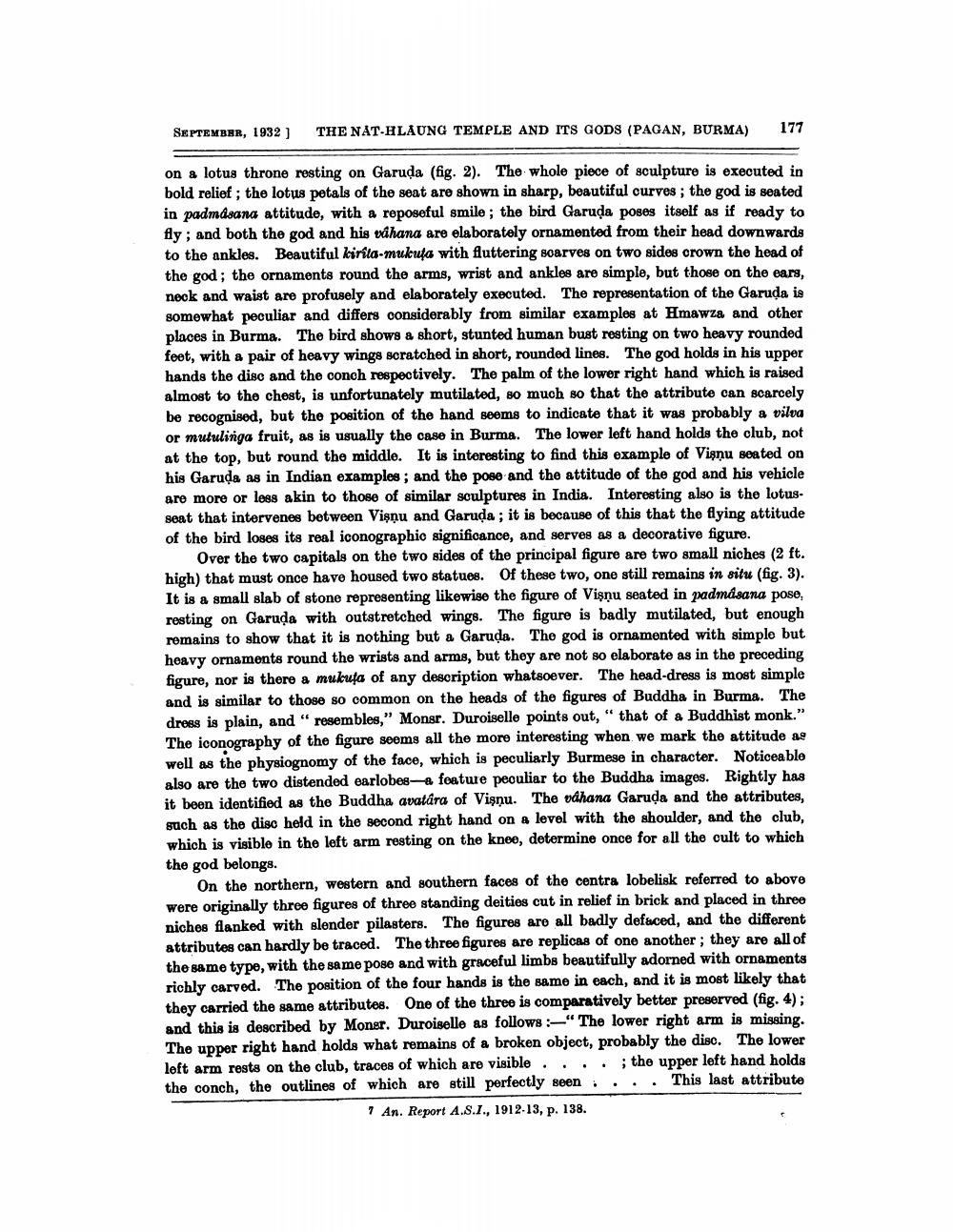________________
SEPTEMBAR, 1932)
THE NAT-HLAUNG TEMPLE AND ITS GODS (PAGAN, BURMA)
177
on a lotus throne resting on Garuda (fig. 2). The whole piece of sculpture is executed in bold relief; the lotus petals of the seat are shown in sharp, beautiful curves; the god is seated in padmasana attitude, with a reposeful smile; the bird Garuda poses itself as if ready to fly; and both the god and his váhana are elaborately ornamented from their head downwards to the ankles. Beautiful kirita-mukufa with fluttering soarves on two sides crown the head of the god; the ornaments round the arms, wrist and ankles are simple, but those on the ears, neck and waist are profusely and elaborately executed. The representation of the Garuda is somewhat peculiar and differs considerably from similar examples at Hmawza and other places in Burma. The bird shows a short, stunted human bust resting on two heavy rounded feet, with a pair of heavy wings scratched in short, rounded lines. The god holds in his upper hands the disc and the conch respectively. The palm of the lower right hand which is raised almost to the chest, is unfortunately mutilated, so much so that the attribute can scarcely be recognised, but the position of the hand seems to indicate that it was probably a vilva or mutulinga fruit, as is usually the case in Burma. The lower left hand holds the club, not at the top, but round the middle. It is interesting to find this example of Vişnu seated on his Garuda as in Indian examples; and the pose and the attitude of the god and his vehicle are more or less akin to those of similar sculptures in India. Interesting also is the lotusseat that intervenes between Vişnu and Garuda; it is because of this that the flying attitude of the bird loses its real iconographic significance, and serves as a decorative figure.
Over the two capitals on the two sides of the principal figure are two small niches (2 ft. high) that must once have housed two statues. Of these two, one still remains in situ (fig. 3). It is a small slab of stone representing likewise the figure of Vişņu seated in padmasana pose, resting on Garuda with outstretched wings. The figure is badly mutilated, but enough remains to show that it is nothing but a Garuda. The god is ornamented with simple but heavy ornaments round the wrists and arms, but they are not so elaborate as in the preceding figure, nor is there a mukuta of any description whatsoever. The head-dress is most simple and is similar to those so common on the heads of the figures of Buddha in Burma. The dross is plain, and resembles," Monsr. Duroiselle points out," that of a Buddhist monk." The iconography of the figure seems all the more interesting when we mark the attitude se well as the physiognomy of the face, which is peculiarly Burmese in character. Noticeable also are the two distended earlobes a feature peculiar to the Buddha images. Rightly has it been identified as the Buddha avatára of Vişnu. The vdhana Garuda and the attributes, such as the disc held in the second right hand on a level with the shoulder, and the club, which is visible in the left arm resting on the knee, determine once for all the cult to which the god belongs.
On the northern, western and southern faces of the centra lobelisk referred to above were originally three figures of three standing deities cut in relief in brick and placed in three niches flanked with slender pilasters. The figures are all badly defaced, and the different attributes can hardly be traced. The three figures are replicas of one another, they are all of the same type, with the same pose and with graceful limbs beautifully adorned with ornaments richly carved. The position of the four hands is the same in each, and it is most likely that they carried the same attributes. One of the three is comparatively better preserved (fig. 4); and this is described by Moner. Duroiselle as follows "The lower right arm is missing. The upper right hand holds what remains of a broken object, probably the disc. The lower left arm rests on the club, traces of which are visible.... ; the upper left hand holds the conch, the outlines of which are still perfectly seen ... This last attribute
An. Report A.S.1., 1912-13, p. 138.




